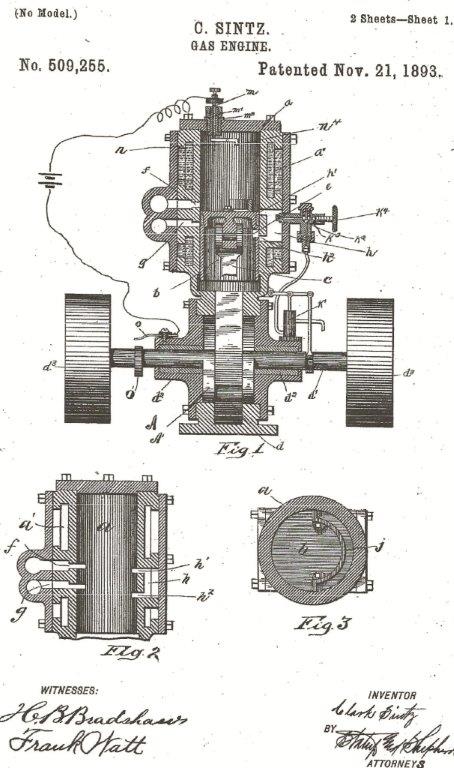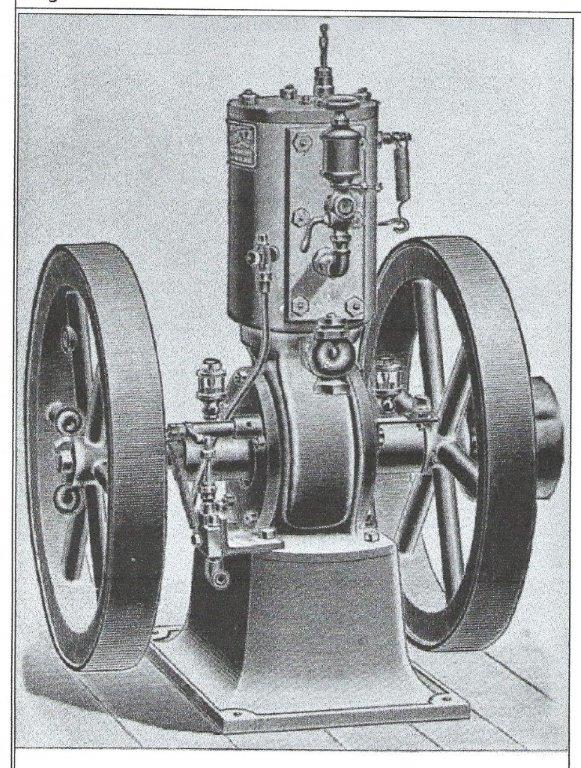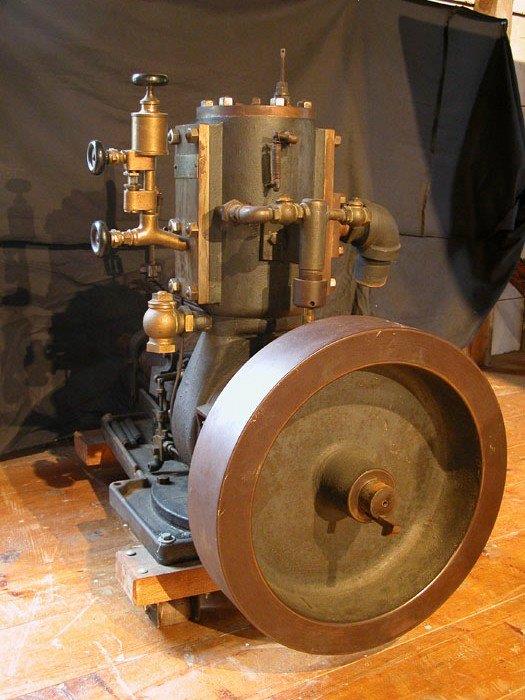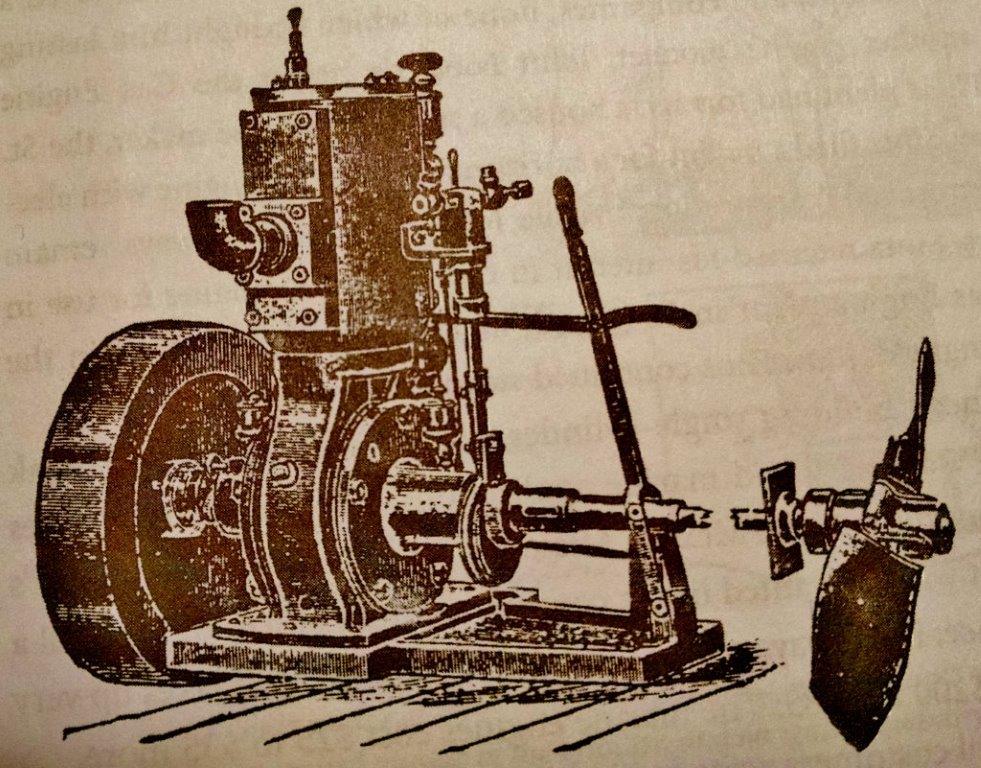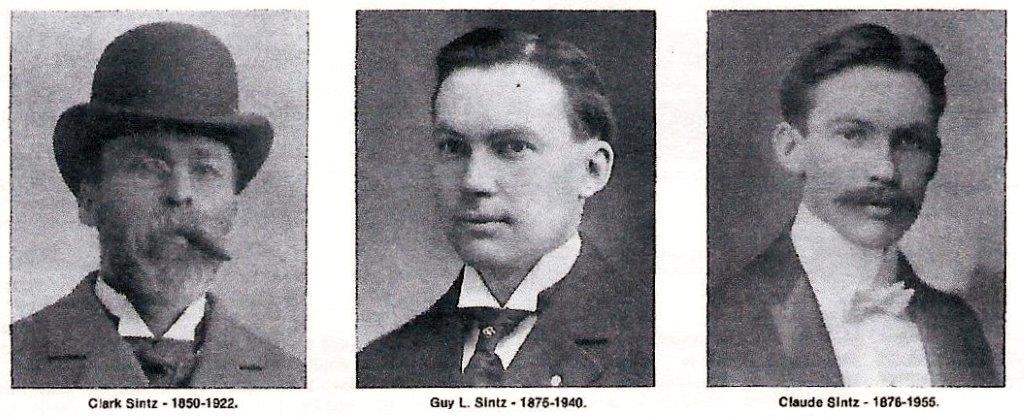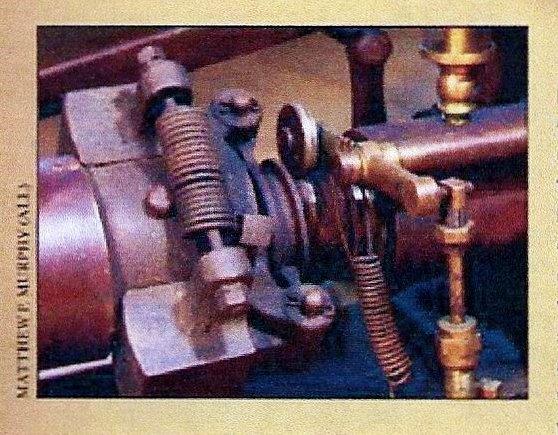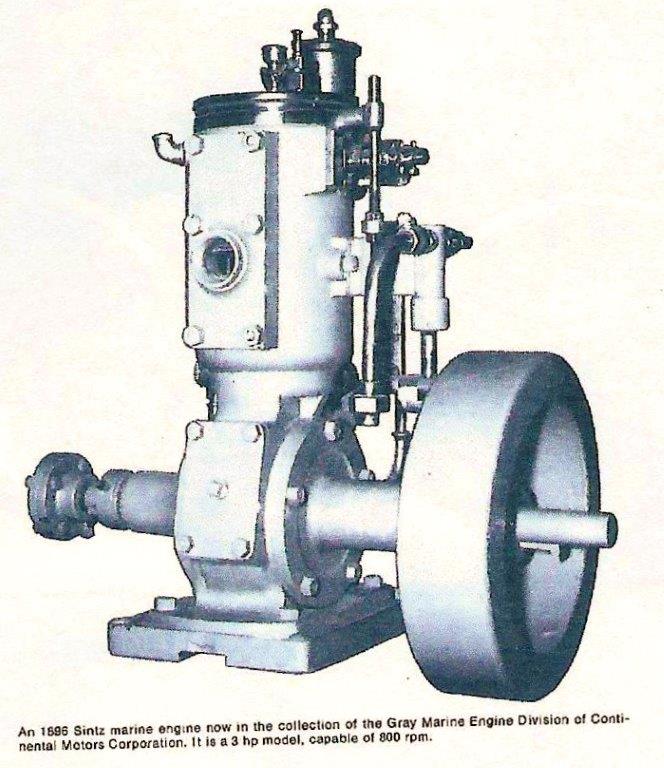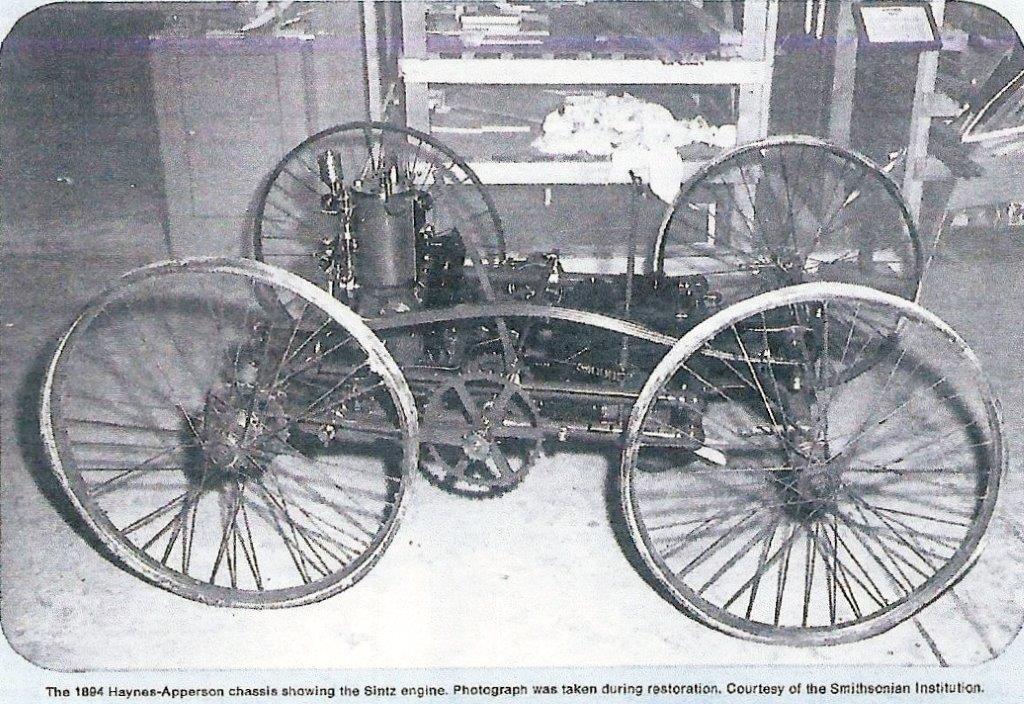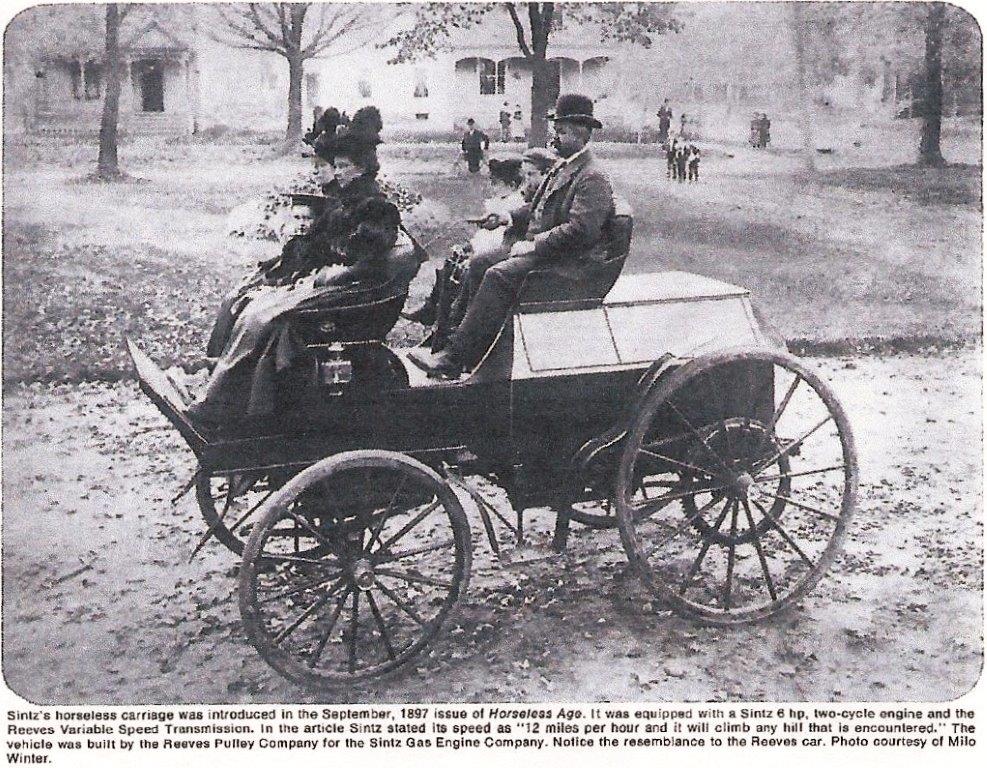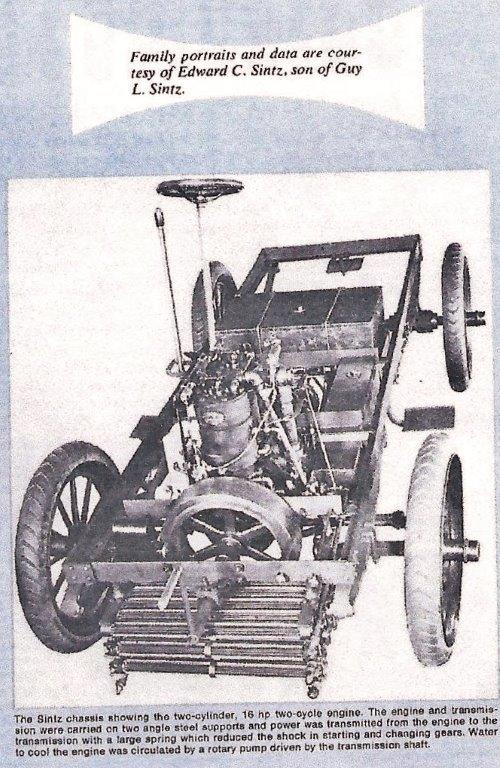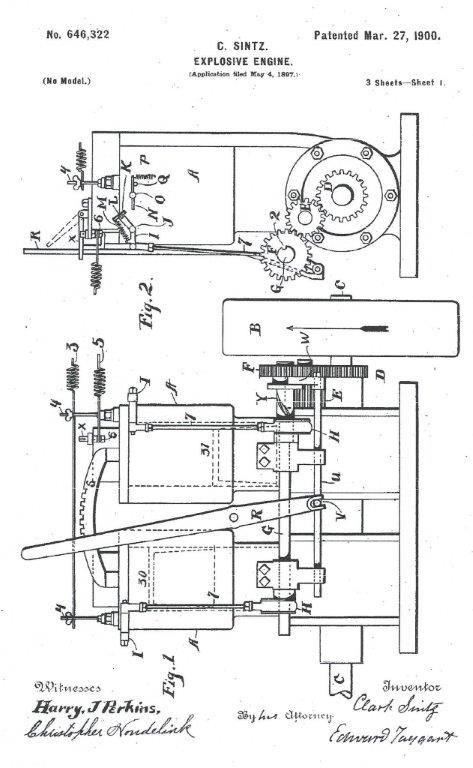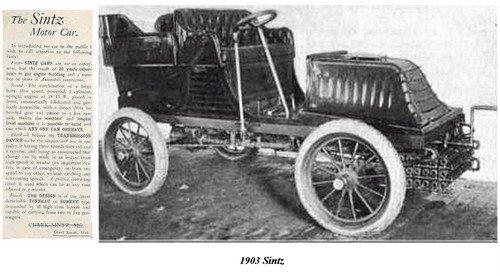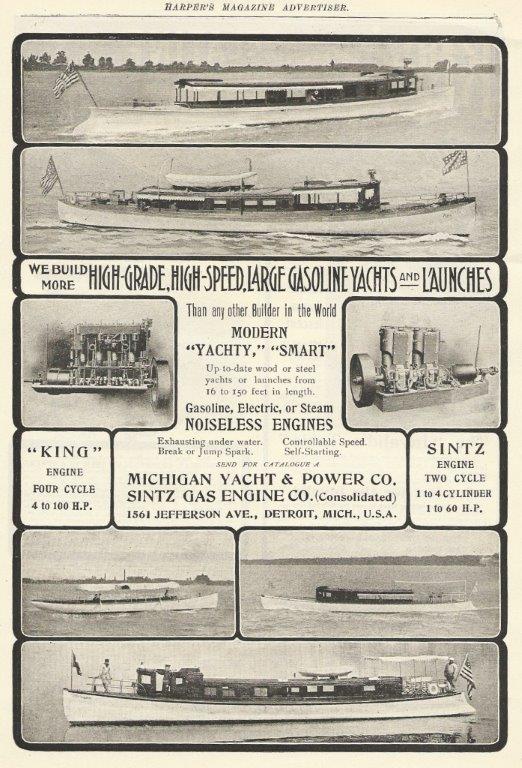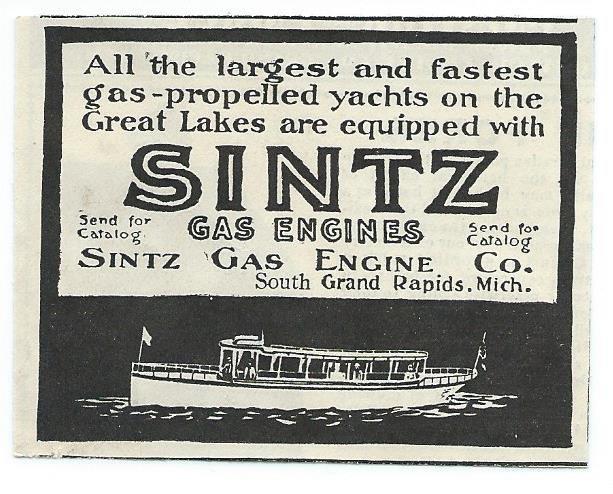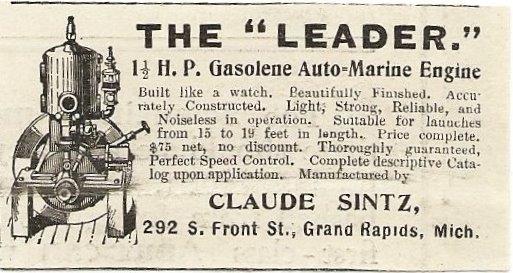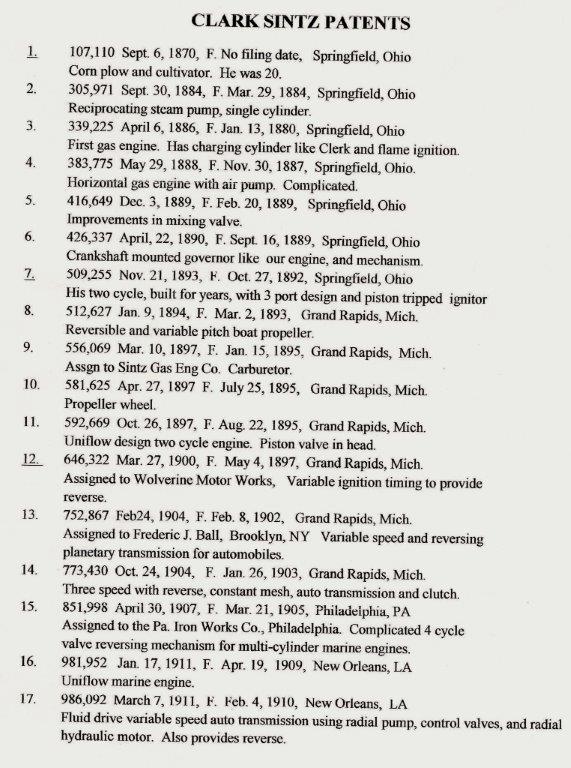|

February 2015
Clark Sintz: His Later Years
By
Paul Harvey
Last month, I chose to write about an engine pioneer
from Ohio, Clark Sintz,
and detailed his early years in Springfield,
Ohio. Amazingly, he patented his first engine
design in 1886, making him one of the earliest gas engine makers of the
entire country. Being inspired to do further investigation by the 1891
Clark Sintz engine displayed in the Founder's Engine House at the
museum, I discovered that Clark was an inventive genius who would rather
move on to the next idea and challenge instead of profiting from the one
he had just completed. Soon his interest focused on boats and
automobiles. This fascinating tale begins in 1893 when Clark, at age 43, had just moved to
Grand Rapids, Michigan, to
have access to Lake Michigan
to build launches that utilized his marine engines, and to continue his
career.
After a brief venture into four-cycle engines during 1891 and 1892, such
as the one displayed at the Coolspring
Power Museum, Clark turned
his attention to the development of the two-cycle engine. Probably his
most significant patent, number
509,255
of November 21, 1893, was the perfection of the three-port,
two-cycle design. This is shown in Photo 1. This engine used
three ports and had no valves, drawing the gasoline from the injector
into the transfer port, and scavenging the air from the crankcase. It
featured a piston-tripped, electric ignitor. The three-port, two-cycle
design is still used today in many applications. Photo 2,
taken from Cassier's Magazine of July 1893, shows this engine
as a stationary model with two flywheels and belt pulley.
By July of 1894, the new Sintz Gas Engine Company of
Grand Rapids, Michigan,
employed 65 people, a tribute to his new two-cycle marine engine
design. To house this flourishing business, an impressive structure,
four stories high, and measuring 45 feet wide by 80 feet long, was
located on 242 Canal Street,
Grand Rapids, Michigan.
The firm built launches ranging from 16 feet to 46 feet long, all
powered by Sintz engines. Despite the success, Clark
soon tired of the new firm and sold out to his shareholders to form the
Wolverine Engine Company. He chose a different name as he did not want
the "mails to get mixed!" More about this later in the article. The
conflict arose when Sintz wanted to replace his existing engine with a
new "uniflow" two-cycle design; patent number
592,669
of August 22, 1895. Although history differs a bit here, he
apparently did not completely divorce himself from the Sintz Gas Engine
Company, as he assigned four other patents to it after 1894.
Photo 3 shows the pristine 1893 Sintz marine engine
located at the Penobscot
Marine Museum
in Searsport, Maine.
Probably the oldest marine engine in the
USA, it was purchased by a gentleman
from Maine in 1893, never
used, and put in storage for a century. It is now a prize in their
collection. Taken from an old advertisement, Photo 4
shows the Sintz marine engine of 1893. Note the lever that could vary
the pitch of the propeller as well as reverse the blades. Ingeniously,
this lever also controlled the stroke of the fuel pump, keeping the
engine at a constant speed regardless of the load.
Photo 5 depicts Clark and his two sons sometime in the
late 1890s. That is Clark to the left, 1850-1922; Guy L. Sintz in the
middle, 1875-1940; and Claude Sintz to the right, 1876-1956. His sons
worked with him on many projects and future developments.
Unlike most two-cycle marine engines, the Sintz used a governor.
Photo 6 is taken from the Wooden Boat's article about the
Penobscot Marine
Museum's 1893 Sintz engine. Interestingly,
Clark patented this governor, number
426,337,
on April 22, 1890. It is the same governor as used
on Coolspring's four-cycle, 1891, engine. The photo shows how the
governor, by a roller on a lever arm, controlled the stroke of the fuel
pump. The entire governor action could be controlled by the propeller
reversing lever mentioned above. Hence, propeller pitch, direction and
engine speed could be controlled easily by the governor and the lever.
This 3 horsepower, 800 rpm, Sintz marine engine was made in 1896. See
Photo 7. It is now in the collection of the Gray
Marine Engine division of Continental Motors Corporation. Most marine
engines built before 1900 had a base plate mounting, while after 1900,
the mounting flanges were at crankshaft centerline to lower the engine's
center of gravity in the boat.
Clark's other love was the automobile, and he
found that his two-cycle engine was equally well adapted to it, as it
was for boats. One of his first vehicles produced in
Grand Rapids, Michigan, is
seen in Photo 8. It is a Haynes-Apperson chassis vintage
1894, using a two-cycle Sintz engine. Sintz introduced his "horseless
carriage" in the September, 1897 issue of Horseless Age. Shown
in Photo 9, it featured a 6 horsepower Sintz two-cycle
engine and a Reeves Variable Speed transmission. Clark
proudly stated that it would attain 12 miles per hour and climb any
hill. Photo 10 shows an advanced Sintz chassis of 1897.
It featured a 16 horsepower, two-cycle Sintz engine. It is unclear
whether the Sintz Gas Engine Company or Wolverine built these vehicles.
As mentioned earlier, Clark sold his interest in
the Sintz Gas Engine Company in order to establish the Wolverine Motor
Company of Grand Rapids,
Michigan. His two sons, Guy and Claude, were
included in this venture. In 1895, 19-year-old Claude obtained the
first patent for the new two-cylinder Wolverine engine. As Claude was a
minor, Clark was appointed guardian of the
patent. I am unable to find this patent. However, Clark's
patent of March 27, 1900,
number
646,322, and shown in Photo 11, was issued to the
Wolverine Motor Company. Depicting a two-cylinder, two-cycle engine, it
featured variable ignition timing enabling the engine to operate in
forward or reverse rotation. Again tiring of the new company, the
Sintzs sold the Wolverine Motor Works to C. L. Snyder in 1902, to begin
manufacturing the Sintz automobile. Wolverine changed ownership and
location several times but flourished until 1955, eventually making
large diesels for both stationary and marine use.
Sintz Automobile Company was opened in Detroit,
Michigan, in 1902 to manufacture a five
passenger tonneau with a two-cylinder, two-cycle engine. See
Photo 12.
The lever to the right controlled the transmission as well as the
clutch. Clark had patented this three-speed,
constant mesh transmission and clutch in 1903; number
773,430.
Although very successful, only six were sold when lack of capital forced
him into liquidation. It was time for Clark to
move on.
The old Sintz Gas Engine Company of Grand Rapids
fared a bit better in its future, In 1902, it was bought by Ora Mulford
and consolidated with the Michigan Yacht Company in
Detroit, Michigan. Here,
according to Beeson's Marine Directory, it was the "largest
yacht and gasoline engine builder on the great lakes." They offered
both the Sintz two-cycle engine and the King four-cycle engine in their
yachts. Note Photo 13. A smaller ad, Photo 14, shows
the Sintz yachts built in 1906, by the above firm. At that time,
Mulford acquired two partners, Paul and David Gray. The Gray Marine
Motor Company, formed in 1925 in Detroit, became one of the
longest-lived marine engine builders in the country.
Guy Sintz continued with various engine businesses for
his entire career. Working in Marshall,
Michigan; Detroit,
Michigan; Pittsburgh,
Pennsylvania; and York,
Pennsylvania; he finally re-united with his
brother Claude in 1923 to become a factory superintendent for him.
Claude Sintz initially formed his own marine engine firm in
Grand Rapids, and produced the "Leader" marine
engine, as shown in Photo 15. His interest then returned
to farm equipment, and he had several patents in that area. He became a
member of SAE in 1917, and formed his own firm, the Claude Sintz
Company, to make specialty automotive parts. It is still in existence
under different management.
Clark Sintz was granted 17 patents from 1870 to 1911.
See Photo 16. His most significant was the 1893 patent of
the three-port, two-cycle engine. This design revolutionized the marine
engine business and it is still used today. However, his last patent,
number
986,092, of March 7, 1911, was the most advanced. He invented
the automatic transmission for automobiles! He depicted the engine
directly driving a three-cylinder, radial hydraulic pump, the output of
which was controlled by his uniquely designed valve, that then operated
a three-cylinder, radial hydraulic motor to power the wheels. One lever
controlled forward, neutral and reverse! The farther the lever was
pushed in either direction, the faster the vehicle traveled; either
forward or reverse. Simple. This would be the hydrostatic transmission
that we know today in so many applications. He sold this patent to the
Manly Hydraulic Drive Company of Philadelphia,
Pennsylvania.
After the failure of the Sintz automobile, he spent two
years in Panama
in charge of the plantation equipment for the United Fruit Company.
Upon return to the United States,
he and his wife, Virgie, settled in New Orleans,
Louisiana, in 1907. There he opened a small
machine shop and continued his love of inventing and experimenting, as
well as doing job work for others. Finally, the couple bought a small
farm in Waveland, Mississippi,
in 1914 and retired on the beautiful Gulf of
Mexico coast.
His grandsons enjoyed spending their summer vacations with them.
Ironically, he was struck by an automobile while crossing a street there
and died of the injuries on
July 12, 1921. Virgie passed away soon after, and their
remains were returned to the Ferncliffe
Cemetery in Springfield,
Ohio. Note Photo 17. This
concludes the tale of one of Ohio's
most unique and inventive geniuses.
References
1. Wooden Boat, March-April 2010, No.
213, "Time Machine."
2. Antique Automobile, March-April 1972,
Vol. 36, No. 2, "Sintz's Important
Contribution to the Birth of the Automobile."
3. Highlights of the Life of Clark Sintz,
Notes written by his son, Claude Sintz,
about 1946.
4. Dialogue with Bob Sintz, Clark's
Great Grandson.
5. Penobscot
Marine Museum,
Searsport, Maine.
6. Cassier's Magazine, May 1893
7. Vintage Advertisement, as noted.
|

